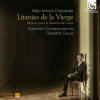Texte paru dans: / Appeared in:

Fanfare Magazine: 37:2 (11-12/2013)
Pour
s'abonner / Subscription information
Les abonnés à Fanfare Magazine ont accès aux archives du
magazine sur internet.
Subscribers to Fanfare Magazine have access to the archives of the magazine
on the net.
Harmonia Mundi
HMC 902169

3149020216927 (ID329)
Consultez toutes les évaluations recensées pour ce cd
~~~~ Reach all the evaluations located for this CD
Louis XIV, a monopolist when it came to the exercise of national power, preferred to employ others of a similar mind in their own specialties. Lully was among the most prominent of these, then and now, who used his control of professional music-making throughout France to banish any competition from the Paris Opéra. The impact on the career of Lully’s greatest potential competitor, Charpentier, was considerable. Denied a public venue for his operas, he turned to composing for private performance among his primary patrons, the wealthy satellite courts that flourished away from Versailles and the Roman Catholic Church. There he was hugely successful, with more than 500 works to his credit. Even the Sun King took great pleasure in his sacred music; and when Charpentier was too ill temporarily to take part in 1683 in a competition for one of the four sous maîtres posts of the Royal Chapel, Louis provided him with a very liberal pension.
Charpentier’s motets form a large part of his extensive production. Accurate dating is next to impossible, and they fit no single, predetermined form. Some are without internal divisions, while others utilize the Roman rondo formula, based around a unifying musical theme. Some are divided into movements that themselves possess internal divisions, while others hint at the aria da capo first popularized in French sacred works by Campra. The motets Sébastien Daucé has chosen for this release fit into the third category, where a division into movements is based on expressive means, and each in turn possesses smaller internal cells of contrasting character, determined by literary content. As with French opera, so here with French sacred music, the Word reigned supreme.
Charpentier’s church music drew almost universal praise, even from the Lullyists. He was especially praised for his expressive text settings, and his fluid use of counterpoint. On this album, the Psallite ergo populi movement of the Annunciate superi shows how he can set three- and four-part textures skipping joyously. Similarly, the first half of the more serious Salus infirmorum (Litanies de la Vierge) features an illustration of two- and three-part imitation in lengthy, lyrically entwined vocal lines against organ continuo.
Daucé is elusive in his liner notes about the frequent shifts of texture he deploys. He needn’t be. Baroque composers were usually quick to take advantage of different instrumental forces, and arrangements, whether personally approved or published in bootleg editions, were frequent. Charpentier possessed an Italianate ear for textural color as an expressive device, ranging from delicate intimacy to polychoral majesty. A piece like the delightful Libera me of the Miserere on this album, with its heightened recitative moving quickly and easily between declamation, dance, declamation, and song, seems tailor-made for Daucé’s sensible textural shifts that never stray outside the possibilities of Marie de Lorraine’s distinguished musical court.
He conducts his Ensemble Correspondances in performances that recall the style and spirit of Hervé Niquet in Lully’s sacred music and Bruno Boterf in Du Mont’s, emphasizing transparency and movement. Some of his singers—the tenor in Hæc enim Virgo (Annunciate superi), the sopranos in Speculum justitiæ (Litanies de la Vierge)—are inclined to slight phrase endings in faster passagework, and occasionally approximate pitches. In general they perform well, however, and enunciate the text clearly; and the bass in the previously mentioned Libera me would impress in any context. The instrumentalists (flutes, strings, theorbo, and organ accompaniment) are all first-rate. Sound is balanced well between the various forces, in a moderate-sized room that avoids the hollow echo and overlong decay rate of cathedral settings.
Definitely recommended. I can only hope that Daucé returns to this repertoire, and soon.
Cliquez l'un ou l'autre
bouton pour découvrir bien d'autres critiques de CD
Click either button for many other reviews


